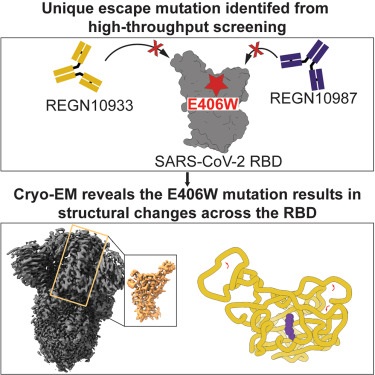Exploring the Shape-Shifting Nature of the SARS-CoV-2 Spike Protein: Unlocking the Secrets of a Mutant Evasion Strategy - The E406W Mutation
COVID-19 News - Shape-Shifting Nature of the SARS-CoV-2 Spike Protein - E406W Mutation May 28, 2023 2 years, 7 months, 1 week, 2 days, 17 hours, 2 minutes ago
COVID-19 News: The SARS-CoV-2 virus, responsible for the ongoing COVID-19 pandemic, is constantly evolving and adapting. As it evolves, the virus finds ways to evade the immune responses triggered by vaccines and prior infections. One mutation in particular, known as the E406W mutation, has been found to help the virus escape the effects of a monoclonal antibody cocktail used in clinical settings.
 Graphical Abstract
Graphical Abstract
Researchers from the University of Washington-USA, Fred Hutchinson Cancer Research Center-USA and Biomed SA, a subsidiary of Vir Biotechnology-Switzerland, have uncovered the structural changes underlying this mutation and its impact on the virus's ability to evade antibodies. Their study findings reveal the remarkable plasticity of the virus's spike protein, shedding light on the ongoing battle between the virus and our immune system.
The Spike Protein and its Importance
The spike protein of SARS-CoV-2 plays a crucial role in the virus's ability to enter host cells. This protein interacts with a receptor called ACE2, initiating the infection process. The spike protein is also the target of most neutralizing antibodies produced by our immune system in response to vaccination or previous infections as covered in previous studies and past
COVID-19 News reports. Additionally, monoclonal antibody cocktails, such as the REGEN-CoV and AZD1061, have been developed to prevent or treat COVID-19 by specifically targeting the spike protein.
Understanding the E406W Mutation
The E406W mutation, located in the receptor-binding domain (RBD) of the spike protein, has been found to render the virus resistant to the REGEN-CoV monoclonal antibody cocktail and the AZD1061 antibody. Surprisingly, the mutation is located outside the areas directly recognized by these antibodies, suggesting that it might affect the overall structure of the RBD in an indirect manner. To investigate this further, researchers used cryoelectron microscopy to analyze the structural changes caused by the E406W mutation.
Unveiling Structural Changes
The cryoelectron microscopy analysis revealed that the E406W mutation led to two distinct conformational states of the spike protein: one with all three RBDs closed and one with one RBD open. The closed state was predominant, accounting for about 70% of the analyzed particles. In the closed state, the E406W mutation induced significant rearrangements in specific regions of the RBD, causing shifts and alterations in neighboring residues. These changes had a cascading effect on the binding sites of the REGEN-CoV and AZD1061 antibodies, making them ineffective against the mutant virus.
Impact on Immune Responses and Vaccines
The E406W mutation also affected the interaction between the spike protein and the ACE2 receptor, reducing the binding affinity. This alteration in the spike protein's shape potentially diminishes the effectiveness of vaccine-elicited neutralizing antibodies.
The study te
am tested plasma samples from individuals who received the Pfizer BNT162b2 or Moderna mRNA-1273 vaccines and found a moderate decrease in neutralizing activity against the E406W mutant compared to the original virus.
This study finding emphasizes the potential impact of viral mutations on vaccine efficacy and the ongoing need for vigilance in monitoring the evolution of SARS-CoV-2.
Implications for the Future
The E406W mutation represents one example of the SARS-CoV-2 virus's ability to adapt and evade immune responses. It is possible that similar mutations affecting the structural organization of the RBD, even if located outside antibody binding sites, may arise in the future. As the virus continues to evolve, variants may accumulate mutations that allow them to escape neutralizing antibodies. This highlights the need for ongoing surveillance and research to stay ahead of the virus's evolution and develop more effective countermeasures.
Furthermore, the study raises the possibility of epistatic interactions, where multiple mutations work together to create a favorable environment for the emergence of variants with enhanced immune evasion capabilities. Some currently circulating variants have already accumulated mutations in the antigenic sites affected by the E406W mutation, further underscoring its potential significance. Understanding these dynamics is crucial for anticipating and preparing for future viral mutations that may pose challenges to our immune responses and existing treatments.
The findings of this study also provide insights into the structural and functional plasticity of the SARS-CoV-2 spike protein. The spike protein is a key target for therapeutic interventions and vaccine development, and its ability to undergo conformational changes in response to mutations highlights the importance of considering the dynamic nature of the virus when designing interventions.
Conclusions
The study of the E406W mutation in the SARS-CoV-2 spike protein provides valuable insights into the mechanisms by which the virus evades immune responses. It highlights the ability of the virus to undergo structural changes that impact the efficacy of therapeutic monoclonal antibodies and vaccine-induced neutralizing antibodies. By understanding the structural and functional plasticity of the spike protein, scientists can better anticipate and respond to the ongoing evolution of SARS-CoV-2. Continued research and surveillance efforts, alongside the development of innovative interventions, will be vital in our ongoing battle against the COVID-19 pandemic and future viral threats.
The study findings were published in the peer reviewed journal: Cell Reports.
https://www.cell.com/cell-reports/fulltext/S2211-1247(23)00632-0
For the latest
COVID-19 News, keep on logging to Thailand Medical News.
